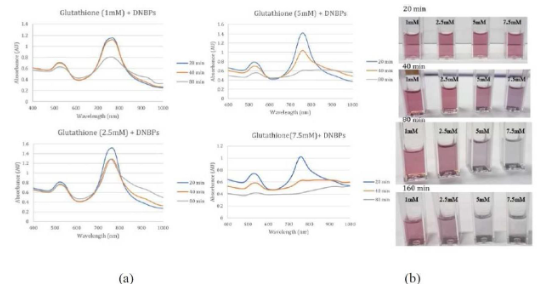The present invention relates to a plasmonic biosensor comprising gold nanobipyramids (AuNBPs) for detection of glutathione. It also relates to a method for detecting glutathione by the AuNBPs based plasmonic biosensor. The developed plasmonic biosensor is simple, cost-effective and detects glutathione with high sensitivity, and reproducibility. The plasmonic bio-sensor has applications for biosensing such as detecting the components of cancer cells.
Figure 1. Concentration dependent colour change of AuNBPs (1a) UV-Vis spectra illustrating the loss of peak upon addition of different concentrations of glutathione; (b) Digital photographs showing colour change for different glutathione concentrations w.r.t. time; Publication: Shubham Pallod, Peng Berney, Rohini Kumari, Nishant Jain, Deepak Chauhan, Mukesh Dhanka, Eaint Honey Aung Win, Michael Teitell, Rohit Srivastava, Pranjal Chandra, Rajendra Prasad, Stimuli-Responsive Molecular Exchange of Structure Directing Agents on Gold Nanobipyramids for Cancer Cell Detection and Synergistic Therapeutics, ACS Appl. Bio Mater., 2024, doi.org/10.1021/acsabm.4c00409.
There is a long felt need to develop a plasmonic biosensor for detection of glutathione that is simple, cost-effective and detects glutathione with high sensitivity and reproducibility.
- High Sensitivity for Early Detection: The biosensor can detect extremely low concentrations of glutathione, making it highly effective for identifying early-stage diseases, including oxidative stress and cancer.
- Simple Colorimetric Detection: It enables visual identification through a clear colour change, allowing rapid qualitative analysis without specialized equipment—ideal for point-of-care and field use.
- Cost-Effective and Reproducible: It utilizes gold nanobipyramids (AuNBPs) that are easy to synthesize with consistent quality, ensuring affordability and scalability for widespread diagnostic use.
- UV-Vis Spectroscopy for Quantitative Analysis: It offers a reliable and accessible method for precise measurement of glutathione levels, enhancing its value in clinical diagnostics and research labs.
- Minimal Instrumentation and Simple Mechanism: Based on straightforward chemistry, the system eliminates the need for complex tools or procedures, making it practical for low-resource or decentralized settings.
- Tunable Optical Properties of AuNBPs: The engineered nanostructures have controllable optical features, allowing for enhanced signal clarity and customization for different diagnostic applications.
The process involves the preparation of AuNBPs by mixing a seed solution with a growth solution to form the sensing medium. This medium exhibits localized surface plasmon resonance (LSPR) properties that are sensitive to molecular interactions. A light source is then directed at the prepared solution, causing incident light to interact with the nano-bipyramids. When a sample containing glutathione is introduced, it interacts with the surface of the nanobipyramids, altering their plasmonic response. The light emanating from the solution after this interaction is detected by a photodetector. The detected optical signals are transmitted to a processor, which analyzes the spectral data to determine the presence and potentially the concentration of glutathione in the sample. This approach provides a sensitive and label-free method for glutathione detection.
The current technology is at laboratory scale and evaluated in vitro level.
3
The present invention offers a low-cost, highly sensitive biosensing solution for detecting glutathione, a critical biomarker for oxidative stress and early-stage cancer detection. By enabling rapid and accurate diagnosis using simple, accessible tools, this technology empowers early intervention and better disease management, especially in resource-limited settings. Its affordability and ease of use make it suitable for widespread clinical and point-of-care applications, improving public health outcomes.
- Biomedical diagnostics
- Clinical pathology and laboratory medicine
- Cancer research and oncology
- Point-of-care testing (POCT) devices
- Biosensor and nanotechnology instrumentation
- Pharmaceutical and drug development
Geography of IP
Type of IP
202021033612
513864

